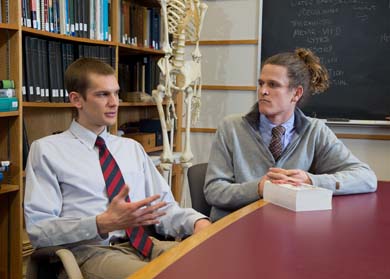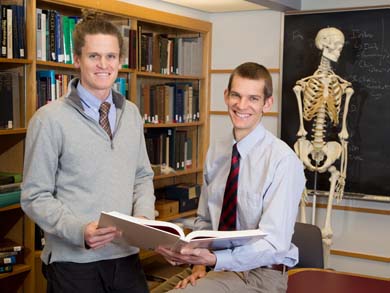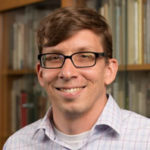
Rembrandt’s 1632 painting “The Anatomy Lesson of Dr. Nicolaes Tulp” captured the importance of human dissection as a critical component in medical education.
A dichotomy is evident in the way the students speak about them, the donors. There’s the occasional slip from she to it, the acknowledgment of names bestowed upon them, even though it’s against the rules. The donor was once a living person after all, a person who now plays a critical role in the education of first-year medical students who are required to take apart a human body in pursuit of the foundational and experiential knowledge that will inform their careers.
At the University of Michigan Medical School, groups of six students will each spend their entire first year with a single donor, moving together unit by unit, system by system, from epidermis to endometrium. In a certain sense, the students will come to know this donor more intimately than anyone ever has—literally holding the donor’s heart in their gloved hands. So, it makes sense that the experience contains an unofficial curriculum with lessons both in empathy and professional detachment.
“It’s quite a privilege—and it felt that way at the time—to be invited by somebody and their family to dissect their body for the sake of your own education,” says Michael Bohl, a fourth-year medical student.

U-M medical students Michael Bohl (left) and Clayton Pratt both wish it had been possible for them to develop a more personal relationship with their donors. (Photo by Scott Soderberg, Michigan Photography.)
Listening to Our Bodies
“The very first incision is the hardest to make,” says first-year student Clayton Pratt, recalling his initial introduction to the anatomy lab. “You see the person as a person. But as soon as the skin is removed, it doesn’t feel like you’re cutting up a person. It feels like you’re a doctor doing an anatomic dissection.”
It was this inherent tension—the opposing impulses toward connection and distance—that prompted Bohl and a fellow student to survey classmates about their feelings toward their donors, and, ultimately, to help launch an innovative new program designed to bring donors and students a bit closer together.
“On the first day, the specialness of the situation, the uniqueness of it, is very much palpable,” says Bohl. “Everybody is very careful about what they do. There’s just a real sense of importance. But it’s almost like by the end of day two, that’s already changed.
“You sort of transition very quickly into a necessary-but-unfortunate detachment—one that you have to have so that you can carry out the donor’s wishes and dissect them,” he continues. “It’s difficult to dissect a person while you’re focusing on their humanity. You have to approach it like an object.”
Reflecting on his two tours of duty in Iraq with the U.S. Marine Corps before medical school, Bohl says the exigencies of wartime familiarized him with the coping mechanisms he later saw in students during the anatomy sequence.
“I felt like I had already been through this process, and I recognized that it’s not going to feel good to be too disconnected from this person,” he says. “In the end it’s going to feel much better if you have a balance—and part of that means maintaining a personal connection. I think in medicine, as well as in the anatomy lab, it’s dangerously easy to totally disconnect yourself. That’s a mistake as a medical student, just like it’s a mistake as a doctor.”
Getting to Know You
Bohl’s survey of his fellow students, published in Anatomical Sciences Education in 2011, revealed the vast majority of respondents wished it had been possible for them to develop a more personal relationship with their donors—with 25 percent giving the maximum value of agreement on a scale of 1-10, and another 25 percent rating the sentiment 8 or 9.
Generally, students are given very little information about their donors, just a smattering of medical records, when available. Pratt, for example, knows his donor was a white woman, probably between 70 and 80, but not much else.
“At the beginning of the year, it was, you know, our donor,” says Pratt, who also is involved in the donor interview project. “But now we always refer to our donor as, ‘How is so-and-so doing?’ We’re not supposed to, because they’re a person and that’s not their name—but you want to have a relationship.”

“You just stop for a moment and think, ‘I wonder what this person’s life was like?’ We don’t talk about it with each other too much. It’s just something you reflect on by yourself,” says Clayton Pratt (left) with fellow student Michael Bohl. (Photo by Scott Soderberg, Michigan Photography.)
Bohl says his group never named their donor. “But I certainly wondered about him. You spend so much time with the person, it’s hard not to look at their face or look at their hands. I might know that his hands looked like he worked hard. And maybe he had emphysema, so perhaps he smoked. You do learn about aspects of their life through the dissection process and it’s hard not to wonder about them,” he says.
The donors come bearing the scars of life’s major and minor traumas: stents, joints that have been replaced, organs tempered by years of use and misuse.
“Every once in a while you stop and think, ‘This person was alive and well six months ago,'” says Pratt. “They might have spent Christmas with their family last year. Or they might not have a family. They may have had a long, distinguished career. Once a week, or every other week, you might just stop for a moment and think, ‘I wonder what this person’s life was like?’ We don’t talk about it with each other too much. It’s just something you reflect on by yourself.”
Pratt and Bohl believe the video interviews could help bridge this chasm and allow students to understand the motivations behind a donor’s gift. The videos also would impart a type of permission: I know what you’re going to do to my body, and I’m OK with it. I want you to do it.
Body of Knowledge
Bohl’s study also explored different ways of thinking about the cadavers. The traditional, Western model presents the body as the students’ first “patient.” But in a seminar led by former U-M anatomy lecturer Sabine Hildebrandt, M.D.—renowned for shedding light on anatomical research under the Third Reich—the students learned about other models. Medical students in Thailand, for example, refer to their donors as ajarn yai—great teachers. Rather than just a semantic nuance, there are important, real-world differences between the donor-as-patient model and the donor-as-teacher model.
“To me, the biggest difference is in the student’s approach to the body,” says Bohl. “I think a donor makes a very poor patient and it establishes an awkward first doctor-patient relationship. This person is not seeking treatment and there’s no service you can offer them.”
Moreover, unlike a true doctor-patient experience, students are given near-complete autonomy. It’s not a fiduciary relationship in which they will decide with the patient how best to proceed. But things shift when one views the donor as a teacher, Bohl explains.
“The donor is somebody who’s made a huge personal sacrifice for our education, much like the great teachers we know,” Bohl says. “And I think it’s a reminder when you go to the anatomy lab that this is a person to be respected, not a person you are free to act on as their fake doctor and do fake surgeries on.”

A marker on the Medical School campus commemorates donors. (Photo courtesy of the U-M Medical School.)
The majority of students in Bohl’s survey felt it would have been beneficial to their future as physicians to have regarded their donors as teachers rather than as patients during that first encounter.
“We found that few people who responded to the survey actually took the donor-as-patient approach seriously,” says Bohl. “The other thing that really surprised us was how many people said they desired a more personal relationship with the donor. Dr. Hildebrandt was particularly surprised by that.”
Hildebrandt, who had a fairly difficult emotional experience in her anatomy course in Germany at age 19, says that while she always had a certain curiosity about the donors whose bodies she dissects, she’s never had a strong desire to know more about them.
“On the whole it is enough for me to know that they have been acquired in an ethical fashion via a voluntary body donation program,” Hildebrandt wrote in a recent email from her current position at Harvard Medical School. “I was actually surprised to hear from my students how many of them, and to what extent, wanted to have more insight into their donors’ lives. However, I was happy to explore this question of a closer connection to the donor with them, and thus we launched the donor interview project.”
Support from Donors
Last October, Bohl was the lead author of a second study, also published in Anatomical Sciences Education, which explored student and donor expectations toward a donor interview program. Nearly three-quarters of students and 81 percent of donors reported they would participate in such a program if it existed. Notably, the paper was the first to survey and report on donor perceptions about being interviewed.
Students provided numerous comments at the end of the surveys, many agreeing the interviews would help create increased empathy and respect for donors—though others articulated concern about losing clinical detachment.
“There were times in anatomy when I had to divorce myself from the fact that this was a person in order to surmount the emotional barrier to dissecting a body,” one student wrote. “I think watching the video would temporarily make this emotional barrier more difficult to surmount, but we’d all surmount it anyway because the donor knew that would be his/her fate and in fact wanted that we should learn from his/her physical body.”
Out of 200 surveys mailed to potential donors and those currently signed up, 54 responses came back. The majority were warm toward the idea, with one donor even offering to help promote the program. Many reported they would feel more at ease with the donation process knowing their interview would accompany their gift.
“I am very comfortable in my decision,” one donor wrote. “What answers could not be found in my life, maybe could be found in my death.”
Telling Their Stories
With the first donor interviews beginning this spring, it will take some time to build up a library of stories and to integrate them into the curriculum. Bohl and Pratt believe the stories will be influential even if students are at first exposed to donors with whom they haven’t worked. And given the concerns expressed by some students, watching the videos will be voluntary. (Likewise, many donors will continue to want to remain anonymous and choose not to record a video.)
Few medical schools have similar programs—the University of Oklahoma, for example, holds an annual luncheon at which medical students can meet family members of the donor they will be dissecting—but Bohl says he was greatly moved by a 2009 documentary film from New Zealand, Donated to Science, in which students watched videotaped interviews of their donors.
“It was remarkable how much it seemed to impact a lot of them,” he says. “Some people realized they had made really unfair and incorrect assumptions about their donor.”
Counterintuitively, it may be the very students who are hesitant to watch the donor interviews who have the most to gain, Bohl and his colleagues note in their second paper. As early as their third year in medical school, these students will be entering into clinical rotations and getting involved with patient care. If they haven’t already learned how to balance empathy and dispassion, there is the potential for the experience to be upsetting, Bohl says.
“My first rotation of my third year was on the cardiology unit,” he says. “The first week I was doing chest compressions on patients who were dying up on the cardiology floor. Anybody who’s done that knows it’s pretty traumatic—you have to break the person’s ribs, the person often vomits blood, and very rarely do they come out of it OK. So if, by the end of your first year, you haven’t started to get the hang of disconnecting yourself when appropriate—and then reconnecting afterward—you might have a really difficult time once you get to the clinical part of your training.”
Learn more about the Medical School’s Anatomical Donation Program.




Elaine Sims - 1964
The donor video program is a wonderful idea. I also know of dissection programs in which the medical students draw portraits of the donor body as a living person and create identities and life stories for them from their observations.
Reply
C. Machcinski
I am an RN. My father donated his body to Wayne State and I plan to do the same.
I think it would be great to leave a little information about my life. This would keep the med students connected to our living spirits; not just working on “an old body.”
Reply
Patricia Lutz - 1971
My husband and I have both enrolled in the donor program and think it would be another important learning experience for the students to know the story of their donor. We would be more than happy to participate in it. I have already had a video made of my husband’s life that we would be glad to share; although it may not address the issues you want covered. Great idea!
Reply
Donna Lipson - 1967
Christine Montross wrote a moving and poetic memoir
“Body of Work” about her relationship with her cadaver,
named Eve, when Montross was a first year med student
at U-M. Highly recommended.
Reply
Carole Jean Stockhausen
Our son was a TA in med school and lost his battle to Melanoma right after he graduated. He donated his body to UofM med school for anatomy as that was close to his heart. His siblings have made a web site about him and we would have loved to share it. When in med school he said the most powerful thing that they had to do was write a letter to the donor’s family at the end of anatomy thanking them for all that they learned.
Reply
Karl Grube
The “survey” is a major advance in teaching and learning.
The videos will become a valuable teaching tool for both student
and professor …. A Great Library to be shared with medical schools
once the new protocols are in place.
Reply
Kelly Kempter
Wonderful work! For further reading on this subject, I highly recommend “Body of Work: Meditations on Mortality from the Human Anatomy Lab” by Christine Montross. It’s a beautifully written account of one first year med student’s experience in the lab. Questions surrounding the balance of connection/dispassion is woven throughout. Fascinating.
Reply
Mitzi Amelon, DO
I think this is a wonderful idea. I remember feeling very thankful to the people who had thought so much about our education. I recall holding someone’s heart in my hand to study the valves and thinking “how generous this person was to have donated his/her heart” and that I would like to do this myself one day. And I will. As Osteopathic Physicians, DOs are taught to look at the patient as a whole person–not as a disconnected sum of “its” parts. I think we all (MDs and DOs) can offer our patients more if we seek to understand them (connect) while at the same time being able to compartmentalize (i.e. put “the business hat” on) to get the job done. It is possible and will make your medical careers much more fulfilling. Every patient will be a teacher.
Reply
JoAnne Simson - 1961
I am an Anatomist by training and have donated my body to the Medical University of S.C., where I taught for many years. When I took Anatomy (at U. of M.), we named our cadaver and made up a whole life story about him based upon some anatomical anomolies he had. I believe I would probably be willing to do a taped interview.
Reply